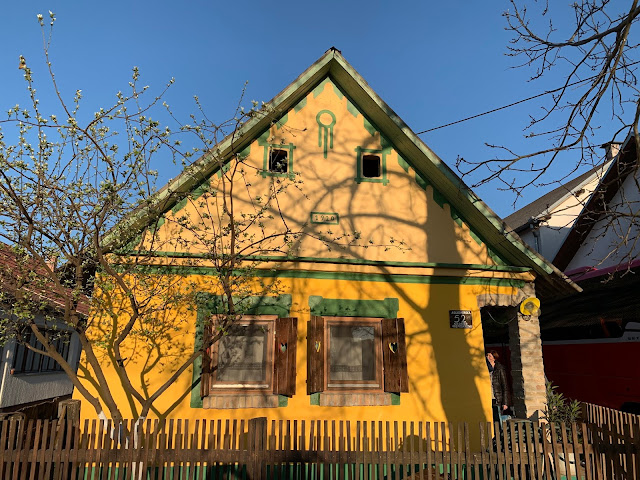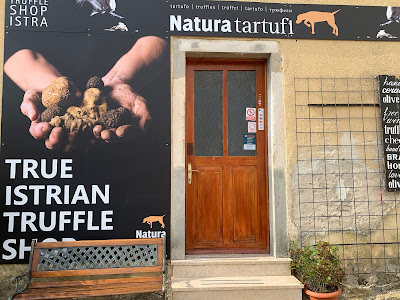As we left Sarajevo behind and headed north in Croatia we were leaving what once been the Ottoman Empire. At the time of its greatest expansion around the late 1600’s its territory stretched from Algiers to Mecca, Belgrade to Basra. Of the Balkans it had encompassed what is now Albania, Montenegro, Bosnia, and a substantial part of Croatia. But there were no more minarets as we neared the border with Hungary. And no more Turkish coffee.
A Farming Town in Croatia
 |
| As all houses were once taxed based on the number of windows facing the street exceeding two, they were built short in front (two windows) and extended far back. |
 |
| The house where I stayed. It too was L-shaped. |
We were in Karanac, a small town in a farming area–in flatland for the first time in a while, and only a dozen miles from the Danube that forms the border with Hungary. You see the drying chilis, and can taste Hungary here in the paprika flavored food. Many locals are Hungarian. The farm where we stayed was almost entirely self-sufficient. We helped prepared some of our food, made cheese, and helped prepare a delicious soup* that was cooked over a fire. All the vegetables came from the farm, as did the eggs, the meat (chicken, home-made sausage), jams, breads, and probably much more. The couple that runs the place are remarkably industrious. Not only do they grow and prepare the food and care for the animals, they have decorated the entire place with stencil designs. It is a model farm in many ways, a deliberate effort to create a farmstay that appeals to visitors. It's no coincidence that on tourist sites the town of Karanac is referred to as an “ethno village,” where one can experience “far gone, past times.”
 |
| One of our hosts, and one of their friendly dogs |
 |
| Many delicious foods came from this kitchen; fresh-made jam-filled donuts are covered on the tabletop. The walls are covered with home-made stencils. |
 |
| We helped make theses cheese the day before. |
 |
| The soup we helped prepare was cooked in clay pots over a wood fire. |
"Far gone, past times" is in some ways all too true. As in other regions of the Balkans, the younger generation is leaving or has already left for greener pastures, metaphorically speaking. Several of the houses in this lovely small town are empty and abandoned if they are not for sale. We met one householder whose son lives in Ireland, another in England. They are hoping to sell but they’re not optimistic. An elderly woman passed by selling eggs from her wheelbarrow. A widow, alone, her grown children far away, she is making do.
 |
| We met this 82-year old woman who was walking down the street selling eggs from a wheelbarrow. Her children live somewhere else in Europe. |
 |
| Our guide Vladka talks with a woman who is hoping to sell her house and move to northern Europe where her children now live. |
Still, the town has possibilities. The L-shape of the Danube-style house lends itself to becoming a row of guest bedrooms. And the houses are available, probably inexpensive. Maybe tourism will provide a better economic future.
 |
| A picture of TIto, once head of what was once Yugoslavia, adorns this abandoned farmhouse in Karanac. |
To make some extra money in hard times many locals took in orphans from the Balkan war as foster children. We were invited for dinner at a nearby house one evening. A member of their family is one of those orphans, now an adult. For him, it worked out happily.
 |
| Dinner at a home down the road. Their foster son, fluent in English, translated. The dad is an avid follower of American sports. |
Past the War Zones: Natural Sites
Unlike the Karanac area, neither Plitvička National Park in Croatia nor Postojna Cave in Slovenia are in need of publicity. In both of these remarkable places we encountered tourist group after tourist group obsessed with selfie-photography. Many visitors took selfies without even looking at what they were standing in front of.
And they were standing in front of some amazing places.
 |
| The entire Plitvička area |
 |
| It must be even more beautiful when the water is high; an unusually dry spring decreased the water flow. |
I’ve been in caves before, but I’ve never been in a cave like Postojna. It's not that the structures are unique, it's the size of it that's impressive. Tram cars, not unlike what one may encounter at, say, Disney World, zip you through underground room after room for about three miles. After the tram ride brings you deep into the cave, you begin a long hike through more of this twelve mile long cave on a path where many have gone before. Tourism is nothing new. The cave has been an attraction since at least 1819 when the Austro-Hungarian Archduke paid a visit. In fact, it was fitted out with electricity before the city of Ljubljana. Tourism priorities! And it has wartime history: In WWI Russian prisoners-of-war were forced to build a bridge over a deep chasm in the cave (part of the trail today), and in WWII occupying German forces used it to store airplane fuel. Which eventually exploded in an attack and destroyed a section of the cave.
A Word on the Countryside
A house at the edge of a small town, houses just outside of town, and houses further from town may all have in common small, neat, hand-worked gardens. The gardens are larger than any garden one might grow to get some fresh tomatoes or zucchini in the summer, but are far from large scale. I saw many people, mostly elderly, hoeing and planting. Each house had neatly stacked firewood. Haystacks were made old-style, the way all haystacks were made before there were mechanical balers. The countryside looked the way Austria probably looked many years ago. At least the parts that I saw.
 |
| Every restaurant in the countryside greeted us with a shot of the local brandy (e.g., slivovitz) |
 |
| A gingerbread-decorating business in a small country town. |
Hill Country and Back to Baroque
Back on the Dalmatian coast I felt far removed from the Balkan war, and in fact those battles didn’t actually reach here, although the area is still part of Croatia. Our guide Vladka lives in this area, and it is the place her brother called home when he was called up to the Yugoslav army during the Balkan war. (See the post “Into the Land of the Balkan War.”)
The Istria peninsula pushes up to Trieste, Italy, and feels very much like Italy, as did Kotor in Montenegro, and Dubrovnik in the southern part of the Dalmatian coast. This is hardly surprising given its history as part of the Venetian Republic, not the Ottoman Empire, for several hundred years until just before 1800.
It’s hard to think of war anyway, when you’re in the land of truffles, olive oil, and wine. And harder still when you’re in a town on the Croatian Riviera, a town like Opatija. Or in a hill town that could as easily be in Tuscany.
 |
| The hill country of Croatia. (This painting is in the "Museum of Naive Art" (folk art) in Zagreb.) |
 |
| A hill town in Istria. Could that be a superhighway at the upper left? Not! It's a canal built in the Napoleonic era. A road follows alongside.. |
 |
| A shop selling truffles both white (white-ish) and black, plus other goodies. |
 |
| Truffle hunting is done with dogs, in this case a lab mix. He was distracted en route by other interesting odors. (If only we had truffles growing here. Goodness knows, I've got the dog for it!) |
By the time we entered Slovenia we were thoroughly back in Baroque. Like Zagreb in Croatia, the architecture in Ljubjana is strongly a product of the Austro-Hungarian Empire. Fairy tale land, surrounded by snowy mountains.
 |
| A fiew of Zagreb from the heights of the old town. Yes, people still smoke here. At least they are neat about where they leave their butts. |
 |
| Ljubljana, a view of the castle and the old town |
 |
| Ljubljana at ground level one rainy day. The downtown is lively and full of bicycles and offers hybrid transport. |
 |
| Waste is separated in all categories; the bins lead to dumpsters under the sidewalk. Ljubljana is one of Europe's greenest cities |
 |
| Lake Bled, castle and village, a short drive from Ljubljana |
It was a good place to end up, Ljubljana. I couldn’t help but think about the waste, both literal (trash) and metaphorical (people without hopeful economic futures) in so many of the other areas I’d just visited. Albania, Montenegro, Bosnia, much of Croatia––all part of Europe, but not the Europe we usually think about. Slovenia, an exception, perhaps, has been more prosperous than the rest of the Balkans for some time. And its capital, Ljubljana, was the only city we visited that was so obviously “green.” Maybe committing to being green is something that only a degree of prosperity allows. I hope not. But a country most likely needs a stable government in order to make such a commitment. It will be a while before that happens throughout the Balkans.
*The soup in Karanac, as I remember it, with guesstimated amounts:
(I made this soon after I got back and it was excellent.)
Black-eyed peas that have soaked overnight (~one cup or so)
Onions, chopped small
Carrots, chopped small
Garlic cloves (several), minced
Celeriac, chopped small (which I couldn’t find, but on impulse used bok choy)
Tomato juice, maybe half a cup
Salt
Paprika, sweet, a generous amount, maybe 1/3 cup
Concentrated chicken bouillon (tablespoonful or more, my best guess to substitute for something added that looked similar)
Water, and an appropriate amount of water.
Meat, cut into small pieces (I didn’t know what kind so I improvised with bacon)
Meat, cut into small pieces (I didn’t know what kind so I improvised with bacon)
Water, appropriate amount
Boil, then simmer for several hours.








No comments:
Post a Comment